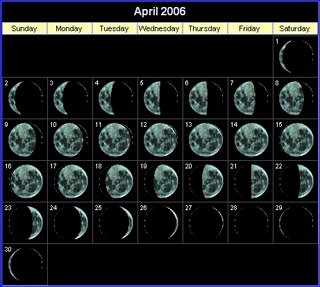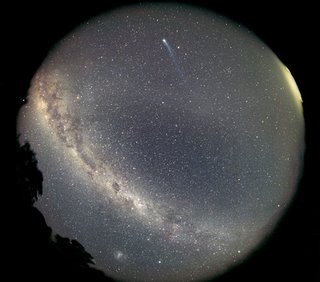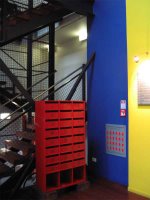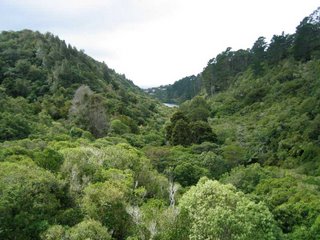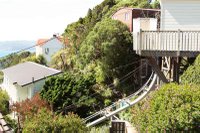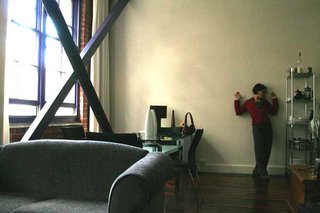Offshore Islands - Ecological Restoration in New Zealand (1)
 Despite the impression conveyed to the outside world, New Zealand's ample open lands did not survive colonization and successive waves of pioneer settlement in pristine condition. Even before the arrival of European explorers, fires spread by Polynesian settlers had dramatically reduced New Zealand's original forest cover. Conversion of land to agricultural uses and extinction of native species accelerated throughout the 19th and early 20th Centuries, when sheep farming transformed vast tracts of wild bush into endless blankets of green pasture. Introduced mammals and plants have devastated remaining native ecosystems. In fact, the scale of destruction and loss is truly overwhelming when you consider how quickly it has taken place.
Despite the impression conveyed to the outside world, New Zealand's ample open lands did not survive colonization and successive waves of pioneer settlement in pristine condition. Even before the arrival of European explorers, fires spread by Polynesian settlers had dramatically reduced New Zealand's original forest cover. Conversion of land to agricultural uses and extinction of native species accelerated throughout the 19th and early 20th Centuries, when sheep farming transformed vast tracts of wild bush into endless blankets of green pasture. Introduced mammals and plants have devastated remaining native ecosystems. In fact, the scale of destruction and loss is truly overwhelming when you consider how quickly it has taken place.  New Zealand was among the very last places on Earth to be settled by human beings. Over the course of just a few hundred years, it has gone from being a unique, isolated remnant of Gondwanaland, to a tamed and familiarized landscape.
New Zealand was among the very last places on Earth to be settled by human beings. Over the course of just a few hundred years, it has gone from being a unique, isolated remnant of Gondwanaland, to a tamed and familiarized landscape.Many of NZ's native species have been severely outcompeted or predated by introduced birds, such as magpies, and animals such as stoats, rabbits, mice, rats, cats, sheep, goats, dogs, deer, pigs, wasps and possums. The problem is severe enough to have caused the extinction of more than one third of native bird species, and to have eliminated a large number of surviving species from their original habitats on the mainland.
 Faced with the enormous responsibility of preserving their rapidly disappearing native animals and plants, conservationists here have developed several intensive and highly unique approaches. These include offshore island reserves, species transfers, pest removal regimes, and the creation of so-called "mainland islands", which I will describe in good time.
Faced with the enormous responsibility of preserving their rapidly disappearing native animals and plants, conservationists here have developed several intensive and highly unique approaches. These include offshore island reserves, species transfers, pest removal regimes, and the creation of so-called "mainland islands", which I will describe in good time.Offshore island reserves have been established on dozens of islands all around New Zealand, many quite close to the mainland, but distant enough to prevent pest species from easily colonizing them. Not all islands managed to avoid the problems of the mainland.
 Restoration efforts have incorporated a heavy investment in livestock removal, cat, possum and stoat trapping, and poisoning to eliminate rodents. However, once eliminated, island reserves have tended to remain free of pests.
Restoration efforts have incorporated a heavy investment in livestock removal, cat, possum and stoat trapping, and poisoning to eliminate rodents. However, once eliminated, island reserves have tended to remain free of pests.At first, these islands were the spontaneous refuge of birds, reptiles, amphibians, insects and plants pushed off the mainland by habitat destruction and predators. In recent decades, conservationists have taken the more drastic step of translocating entire populations of species on the verge of extinction (e.g. kakapo, saddlebacks, black robin, etc.) to predator-free offshore island refuges where they have never occurred naturally. Although risky, these transfers were essentially last-ditch efforts to preserve native species in the wild, and they have paid off by successfully establishing breeding populations of animals that would otherwise have been eliminated.
 Kapiti Island, located just an hour up the coast from central Wellington (pictured throughout), is among the oldest of NZ's offshore island nature reserves. Despite its proximity to the city, relatively few Wellingtonians take advantage of the opportunity to visit. Entrance is strictly controlled by a daily quota permit system and overnight camping is not allowed. Jay and I were lucky enough to accompany the Victoria University Tramping Club for a day hike there in May.
Kapiti Island, located just an hour up the coast from central Wellington (pictured throughout), is among the oldest of NZ's offshore island nature reserves. Despite its proximity to the city, relatively few Wellingtonians take advantage of the opportunity to visit. Entrance is strictly controlled by a daily quota permit system and overnight camping is not allowed. Jay and I were lucky enough to accompany the Victoria University Tramping Club for a day hike there in May.Kapiti is famous for its thriving communities of rare birds. We had the opportunity to see and record the sounds of many of them on our four-hour wander over the island. Below and at left is the takahe, a flightless member of the rail family.
 These birds were thought to be extinct until the 1940s, when an isolated group were discovered in the high alpine tussocks of Fiordland. They are grass-eaters, and have been primarily threatened by the spread of deer throughout their mountain habitat. (Deer are considered a pest in NZ, and hunting season on them is open year-round.) Their numbers have been added to with the aid of a captive breeding program. This particular takahe is the matriarch of the group on Kapiti Island, literally mother or grandmother to every bird present (with the exception of one new arrival). We interrupted her enjoying her afternoon tea, one carefully-chosen blade of grass at a time.
These birds were thought to be extinct until the 1940s, when an isolated group were discovered in the high alpine tussocks of Fiordland. They are grass-eaters, and have been primarily threatened by the spread of deer throughout their mountain habitat. (Deer are considered a pest in NZ, and hunting season on them is open year-round.) Their numbers have been added to with the aid of a captive breeding program. This particular takahe is the matriarch of the group on Kapiti Island, literally mother or grandmother to every bird present (with the exception of one new arrival). We interrupted her enjoying her afternoon tea, one carefully-chosen blade of grass at a time.
Another flightless bird in abundance on Kapiti is the weka. Weka are very well camouflaged, and their presence is mainly betrayed by copious scratching and shuffling sounds in the dead leaves of the undergrowth. In other parts of the world, such sounds would lead you to expect a squirrel or a rabbit, but in New Zealand they are invariably caused by birds. Weka are gutsy and fast-moving. They are especially skilled at targeting unattended lunches, and are said to be able thieves of shiny objects that catch their eye.

The New Zealand robin is much smaller than its North American counterparts. A tiny, gray bird with a puffed, rounded body, stubby tail and thin stilts for legs, it offers an incredibly pleasing profile. Here you can see one with a leaf beside it for comparison of scale. Robins tend to hop along unobtrusively behind trampers, often approaching very close, looking for insects stirred up by our footsteps.
The dominant sound chorusing throughout the canopy in all
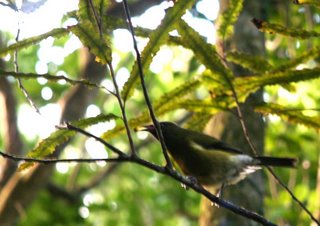 corners of Kapiti Island is the melodious call of the bellbird (at left). We sometimes hear these birds singing outside our windows at home, but their numbers are sparse (due to the city's high density of cats) and their presence is irregular. On the island, the trees fairly pulsed with their song. It was a small taste of what early visitors to the vast forests of this land must once have experienced. Amidst the bellbirds, we heard the calls of tieke, or saddleback, and hihi, or stitchbird, and the ever astonishing tui.
corners of Kapiti Island is the melodious call of the bellbird (at left). We sometimes hear these birds singing outside our windows at home, but their numbers are sparse (due to the city's high density of cats) and their presence is irregular. On the island, the trees fairly pulsed with their song. It was a small taste of what early visitors to the vast forests of this land must once have experienced. Amidst the bellbirds, we heard the calls of tieke, or saddleback, and hihi, or stitchbird, and the ever astonishing tui. 
After hiking to the top of Kapiti's stark western cliffs and taking in the view over the Tasman Sea, we descended through the dense forest and back to the marshy flats near the island's seashore. In the bushes near our boat's landing site, we had a close encounter with a kereru, or NZ native wood pigeon (below). These birds may look somewhat similar to typical pigeons, but they are at least twice their size, much more lovely with their iridescent green and purple plumage, and very different in their comportment.
 Kereru are very silent and ponderous birds. They rarely coo, but they make an alarming racket whenever they fly, their wing feathers whistling and whirring with the strain of keeping their plump bodies aloft. The sight of such a large bird perching incongruously on a slender branch above your head never fails to give you a start. Unfortunately, although not endangered, these birds are becoming less and less common.
Kereru are very silent and ponderous birds. They rarely coo, but they make an alarming racket whenever they fly, their wing feathers whistling and whirring with the strain of keeping their plump bodies aloft. The sight of such a large bird perching incongruously on a slender branch above your head never fails to give you a start. Unfortunately, although not endangered, these birds are becoming less and less common.As we returned to the pebbled beach to watch the shadows lengthen and await our boat ride back to the coast, we passed a pair of pukeko
 watching from among the tussocks. These lovely birds are related to the brightly colored takahe, but they are swamp dwellers, and possess a wader's long legs. They can fly, but they do so in a very ungainly way, almost as if they were halfway to giving it up entirely.
watching from among the tussocks. These lovely birds are related to the brightly colored takahe, but they are swamp dwellers, and possess a wader's long legs. They can fly, but they do so in a very ungainly way, almost as if they were halfway to giving it up entirely.Although our time on Kapiti was brief, the abundance of wildlife and rich biodiversity on this offshore island reserve made its conservation value immediately clear. These islands provide a measure of safety against the excesses of mainland ecological degradation and provide a supply of animals and plants for ongoing restoration efforts. More on those efforts to follow in my next dispatch...

